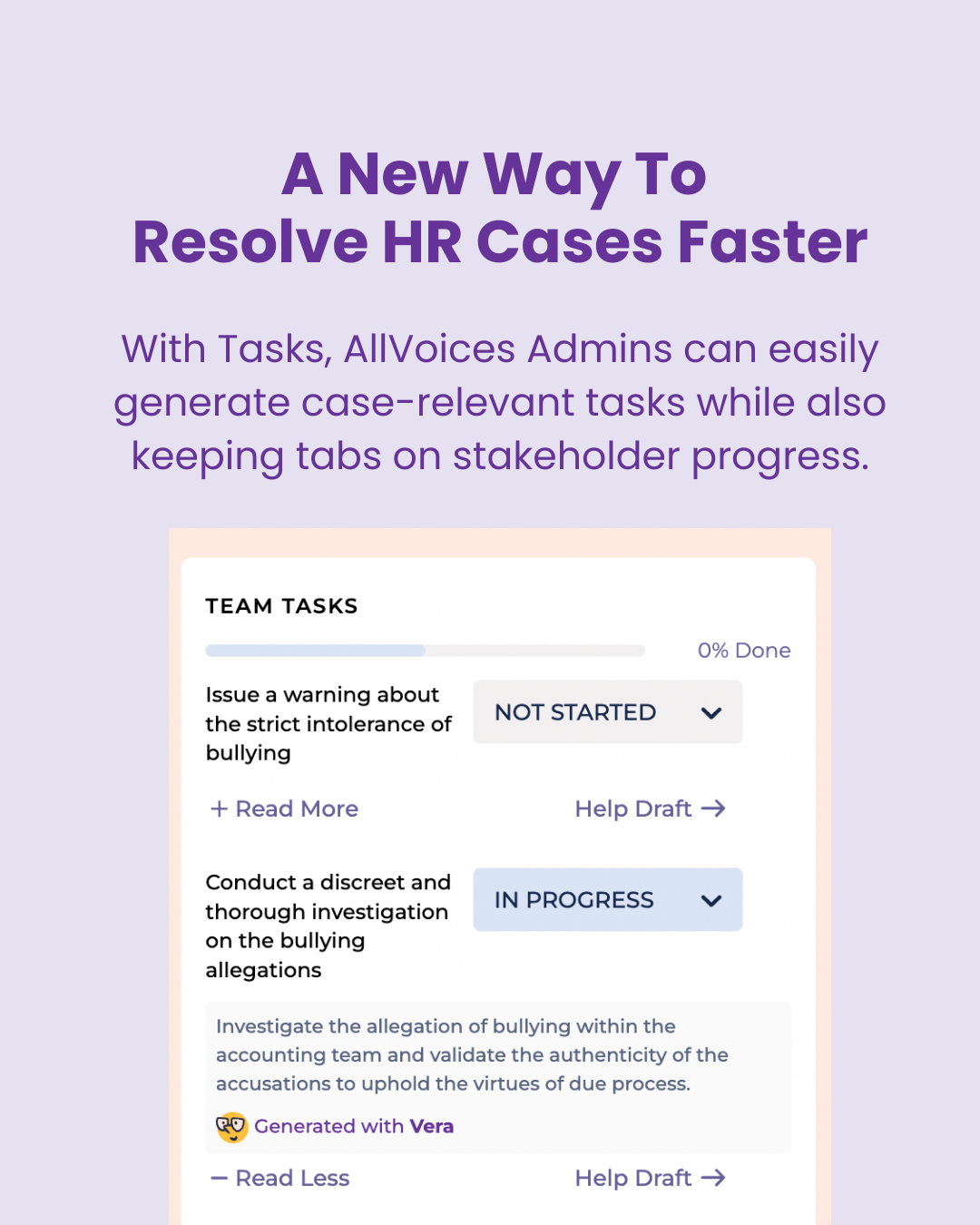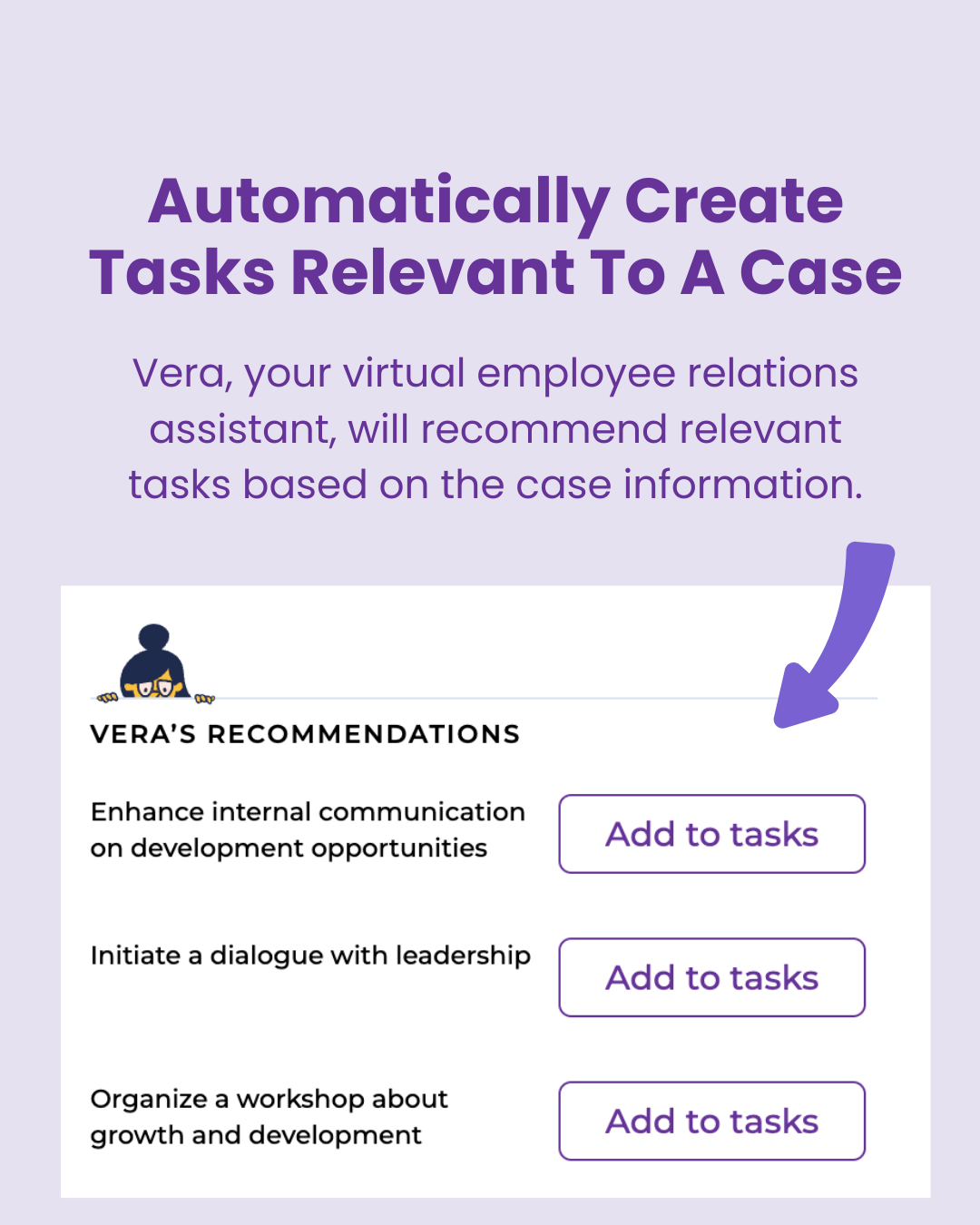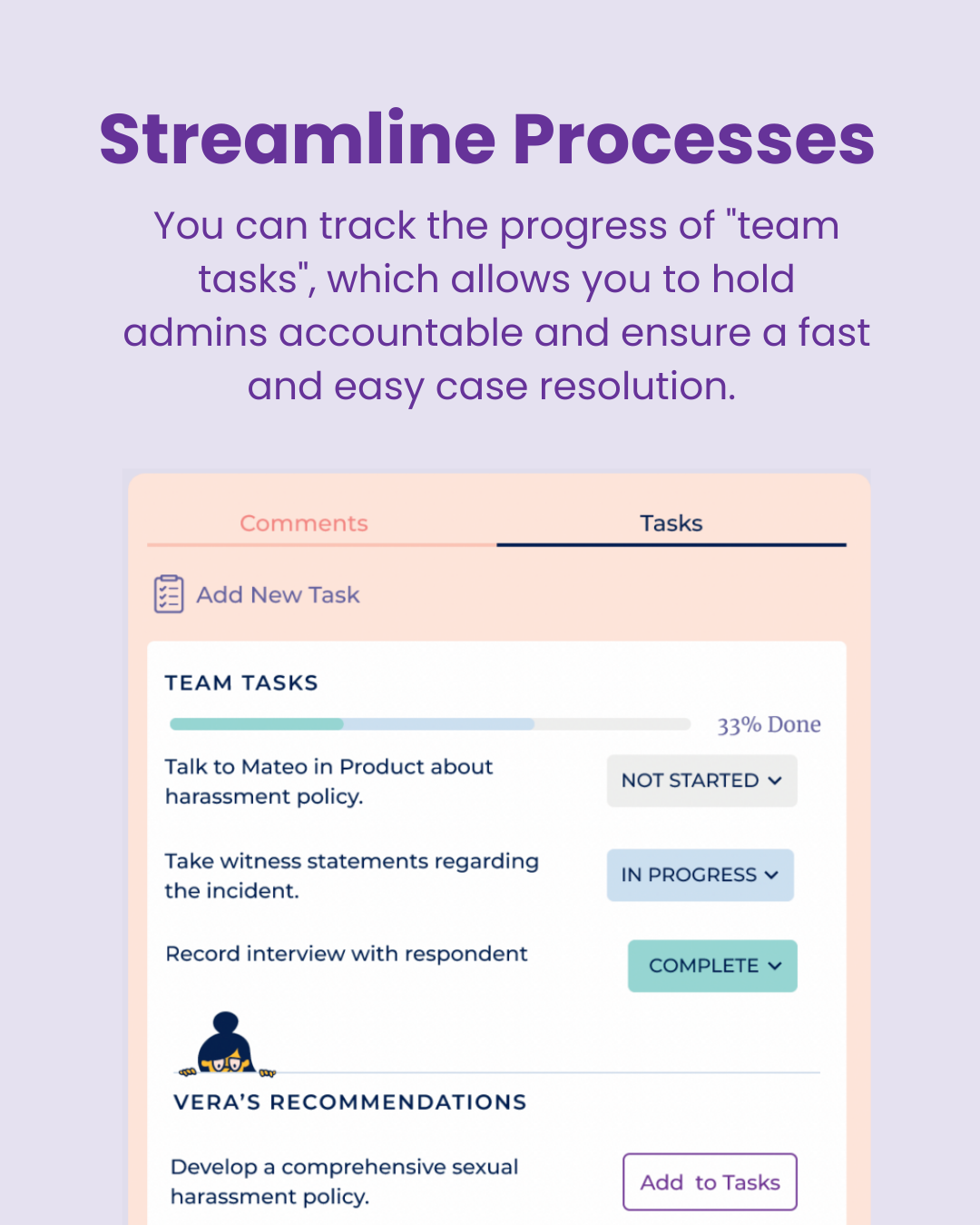
Resolving employee relations cases is a delicate and vital aspect of fostering a harmonious and productive work environment. When conflicts, grievances, or misunderstandings arise among employees, addressing them promptly and effectively is crucial to maintaining team morale and organizational cohesion.
The process involves careful investigation, open communication, and fair judgment. By offering a platform for employees to voice their concerns and grievances, organizations can demonstrate their commitment to creating a supportive and respectful workplace. A successful resolution not only resolves the immediate issue but also helps build a foundation of trust and transparency, contributing to improved employee satisfaction and overall company success.
Resolving employee cases is a critical aspect of effective workplace management, as it directly influences the overall health and dynamics of an organization. Unresolved conflicts or grievances have the potential to poison the work environment, creating an atmosphere of tension, resentment, and unease among employees. Such negative energy not only hampers individual productivity but can also spread, affecting team collaboration and overall organizational performance.
Addressing employee cases promptly is a proactive approach that demonstrates an organization's commitment to maintaining a harmonious workplace. When employees see that their concerns are taken seriously and handled fairly, they are more likely to feel valued and supported. This fosters a sense of trust and loyalty, making them more engaged and motivated to contribute their best to the company.
Unresolved employee cases can escalate into legal issues, tarnishing the organization's reputation and draining valuable resources on litigation. By resolving cases swiftly and effectively, organizations can mitigate legal risks and prevent potential damage to their image.
In essence, the importance of resolving employee cases lies in its power to shape the overall work environment, enhance employee morale, boost productivity, and protect the organization's integrity. It's an investment in creating a positive, respectful, and collaborative workplace that benefits both employees and the organization's long-term success.
At AllVoices, we understand the pivotal role that effective employee relations play in creating a thriving workplace. We're excited to unveil our latest innovation: "Tasks" by AllVoices. This dynamic feature revolutionizes the way you manage employee relations cases, making the process smoother, more intuitive, and efficient.
With "Tasks," AllVoices Admins gain a robust toolset for simplifying case management. Picture effortlessly generating case-specific tasks while maintaining a clear overview of stakeholder progress – all thanks to "Tasks." Vera, our virtual employee relations assistant, takes things up a notch by suggesting pertinent tasks based on the specific case details. It's like having a seasoned expert right at your side, guiding you towards optimal case resolution strategies.

If you don't want to automatically create "Tasks" with Vera, you can also manually create tasks tailored to the specific nuances of your case. Whether you're addressing conflicts, grievances, or employee inquiries, "Tasks" ensures you have a structured roadmap to manage even the most intricate scenarios.

One of the standout features of "Tasks" is its ability to monitor "team tasks." This aspect enables you to foster collaboration and accountability among admins, facilitating efficient case resolutions. By providing transparency, you can keep track of task progress within your team, ensuring that no case gets overlooked.
Our focus extends beyond a mere feature – we're driven to provide a solution that transforms how organizations navigate employee relations management. With a firm commitment to nurturing collaborative workplaces, boosting productivity, and upholding reputations, we channel these values into each innovative step we take.

We hope that you give "Tasks" a look, and we hope you get to see why we're the industry-leading employee relations platform.
Navigating employee relations cases requires a systematic and thoughtful approach. Here are 7 tasks that should be completed in every employee relations case:
The initial case assessment is a critical step in effectively managing employee relations cases. It sets the tone for the entire resolution process by providing a comprehensive understanding of the situation and its context. Here's a deeper dive into the components and importance of the initial case assessment:
An effective initial case assessment lays the groundwork for informed decision-making and a well-rounded understanding of the situation. By taking the time to gather information, understand concerns, and analyze context, you position yourself to address the case in a fair, objective, and thorough manner. This assessment not only informs subsequent tasks but also demonstrates your commitment to maintaining a just and supportive work environment for all employees.
In the realm of HR cases, effective communication with those at the heart of the matter is the linchpin of successful resolutions. Picture scenarios like conflict resolution or addressing concerns – here's how it works:
Communication isn't just talk – it's the adhesive in HR case solutions. Open channels, diverse viewpoints, and a smoother path to resolution.
Conducting investigations for employee relations cases resembles peeling back layers to reveal the truth. It entails systematically gathering diverse pieces of information – including statements, documents, and evidence – to construct a comprehensive narrative. The process adheres to an unwavering commitment to impartiality, carefully analyzing each element much like a forensic examination of clues. By delving into root causes, upholding the utmost confidentiality, and meticulously documenting the journey, investigations aim to unveil the underlying motivations behind incidents. Ultimately, they serve as the foundation for well-informed decision-making, fostering equitable resolutions that uphold fairness and transparency.
Picture investigations as the discerning pursuit of hidden truths within the realm of employee relations cases. Whether addressing interoffice tensions or potential transgressions, this process involves methodically collecting and interlocking pieces of information. Objectivity remains paramount, ensuring that each fragment is examined impartially, much like assembling a complex puzzle. By identifying consistent patterns, uncovering intrinsic motivations, and safeguarding the confidentiality of the process, investigations strive to unearth the fundamental narrative. Every progression is meticulously documented to maintain a clear record, culminating in insights that inform sound decisions and pave the way for resolutions grounded in fairness and integrity.
Crafting tailored resolution plans for employee relations cases is like strategizing a unique pathway through intricate scenarios. Think workplace conflicts or performance matters – that's where personalized planning shines. It's about grasping the specifics, akin to a shrewd business planner studying the landscape. This approach delves into the case's nuances, considering factors like the parties involved, organizational dynamics, and legal considerations. The goal? A solution that not only tackles the immediate issue but also paves the way for lasting collaboration and growth.
Tailored resolution planning operates like an architect's blueprint for navigating employee relations complexities. Whether it's disputes or development prospects, this process involves dissecting every aspect of the situation. Like an architect examining each detail of a building design, tailored planning dives into the intricacies. It's about understanding the individuals, the context, and the bigger organizational picture. By weaving in legal aspects, company culture, and the goals of all parties, this planning ensures not just quick fixes, but sustainable pathways to resolution that align with business growth.
Mastering the art of clear communication for outcome delivery in employee relations is akin to presenting a strategic report to stakeholders. Consider scenarios like conflict resolution or policy changes – this is where effective communication takes the spotlight. It's about translating intricate details into understandable insights, much like a savvy business communicator breaking down complex data. This approach involves distilling the essence of outcomes, explaining the reasoning behind decisions, and outlining the potential impact. By aligning messages with the audience's needs and concerns, clear communication of outcomes fosters understanding, cooperation, and informed next steps.
Clear communication of outcomes is your executive brief in the world of employee relations. Whether it's addressing issues or rolling out new initiatives, this process involves delivering insights in a straightforward manner. Think of it as a CEO simplifying complex business concepts. The focus is on conveying the heart of the matter – the outcomes, the rationale, and the implications. By ensuring that the messages resonate with the audience – be it employees, managers, or stakeholders – clear communication of outcomes not only builds transparency but also encourages collaboration and actionable responses.
Supervising implementation and follow-up in employee relations mirrors tracking the execution of a strategic plan. Imagine scenarios like policy changes or performance improvement – that's where meticulous oversight comes into play. It's about ensuring actions align with the plan, much like a vigilant project manager overseeing milestones. This approach involves monitoring the execution, addressing any challenges that arise, and confirming that intended outcomes are realized. By maintaining a keen eye on progress and offering support where needed, effective implementation monitoring and follow-up ensure that initiatives stay on course, objectives are met, and adjustments are made as required.
Monitoring implementation and follow-up in employee relations is akin to quality control in a business process. Whether it's policy execution or change management, this process involves keeping a finger on the pulse. Think of it as the supervisor checking each step in a manufacturing line. The focus is on observing the journey from start to finish – tracking actions, evaluating results, and addressing hiccups along the way. By ensuring that plans are executed as intended, and by offering guidance and course correction when necessary, implementation monitoring and follow-up guarantee that goals are achieved efficiently and that the desired outcomes are effectively realized.
Should note, that features like "Tasks" enable Admins and key stakeholders of AllVoices to ensure that they're processing with employee relations cases.
Documentation and analysis in employee relations mirror compiling a comprehensive business report. Think of scenarios like performance evaluations or compliance matters – that's where meticulous documentation and insightful analysis come into play. It's about recording details and extracting meaningful insights, much like a thorough financial analyst reviewing data trends. This approach involves documenting relevant information, such as actions taken and decisions made, and analyzing the data for patterns, implications, and opportunities. By maintaining thorough records and conducting insightful analysis, organizations ensure transparency, informed decision-making, and the ability to fine-tune strategies for future success.
By consistently completing these 7 tasks in every employee relations case, you establish a structured and effective approach that promotes fairness, transparency, and positive relationships within your organization.
Learn more about Tasks by scheduling a demo, and learn why we're the industry-leading employee relations platform.

Resolving employee relations cases is a delicate and vital aspect of fostering a harmonious and productive work environment. When conflicts, grievances, or misunderstandings arise among employees, addressing them promptly and effectively is crucial to maintaining team morale and organizational cohesion.
The process involves careful investigation, open communication, and fair judgment. By offering a platform for employees to voice their concerns and grievances, organizations can demonstrate their commitment to creating a supportive and respectful workplace. A successful resolution not only resolves the immediate issue but also helps build a foundation of trust and transparency, contributing to improved employee satisfaction and overall company success.
Resolving employee cases is a critical aspect of effective workplace management, as it directly influences the overall health and dynamics of an organization. Unresolved conflicts or grievances have the potential to poison the work environment, creating an atmosphere of tension, resentment, and unease among employees. Such negative energy not only hampers individual productivity but can also spread, affecting team collaboration and overall organizational performance.
Addressing employee cases promptly is a proactive approach that demonstrates an organization's commitment to maintaining a harmonious workplace. When employees see that their concerns are taken seriously and handled fairly, they are more likely to feel valued and supported. This fosters a sense of trust and loyalty, making them more engaged and motivated to contribute their best to the company.
Unresolved employee cases can escalate into legal issues, tarnishing the organization's reputation and draining valuable resources on litigation. By resolving cases swiftly and effectively, organizations can mitigate legal risks and prevent potential damage to their image.
In essence, the importance of resolving employee cases lies in its power to shape the overall work environment, enhance employee morale, boost productivity, and protect the organization's integrity. It's an investment in creating a positive, respectful, and collaborative workplace that benefits both employees and the organization's long-term success.
At AllVoices, we understand the pivotal role that effective employee relations play in creating a thriving workplace. We're excited to unveil our latest innovation: "Tasks" by AllVoices. This dynamic feature revolutionizes the way you manage employee relations cases, making the process smoother, more intuitive, and efficient.
With "Tasks," AllVoices Admins gain a robust toolset for simplifying case management. Picture effortlessly generating case-specific tasks while maintaining a clear overview of stakeholder progress – all thanks to "Tasks." Vera, our virtual employee relations assistant, takes things up a notch by suggesting pertinent tasks based on the specific case details. It's like having a seasoned expert right at your side, guiding you towards optimal case resolution strategies.

If you don't want to automatically create "Tasks" with Vera, you can also manually create tasks tailored to the specific nuances of your case. Whether you're addressing conflicts, grievances, or employee inquiries, "Tasks" ensures you have a structured roadmap to manage even the most intricate scenarios.

One of the standout features of "Tasks" is its ability to monitor "team tasks." This aspect enables you to foster collaboration and accountability among admins, facilitating efficient case resolutions. By providing transparency, you can keep track of task progress within your team, ensuring that no case gets overlooked.
Our focus extends beyond a mere feature – we're driven to provide a solution that transforms how organizations navigate employee relations management. With a firm commitment to nurturing collaborative workplaces, boosting productivity, and upholding reputations, we channel these values into each innovative step we take.

We hope that you give "Tasks" a look, and we hope you get to see why we're the industry-leading employee relations platform.
Navigating employee relations cases requires a systematic and thoughtful approach. Here are 7 tasks that should be completed in every employee relations case:
The initial case assessment is a critical step in effectively managing employee relations cases. It sets the tone for the entire resolution process by providing a comprehensive understanding of the situation and its context. Here's a deeper dive into the components and importance of the initial case assessment:
An effective initial case assessment lays the groundwork for informed decision-making and a well-rounded understanding of the situation. By taking the time to gather information, understand concerns, and analyze context, you position yourself to address the case in a fair, objective, and thorough manner. This assessment not only informs subsequent tasks but also demonstrates your commitment to maintaining a just and supportive work environment for all employees.
In the realm of HR cases, effective communication with those at the heart of the matter is the linchpin of successful resolutions. Picture scenarios like conflict resolution or addressing concerns – here's how it works:
Communication isn't just talk – it's the adhesive in HR case solutions. Open channels, diverse viewpoints, and a smoother path to resolution.
Conducting investigations for employee relations cases resembles peeling back layers to reveal the truth. It entails systematically gathering diverse pieces of information – including statements, documents, and evidence – to construct a comprehensive narrative. The process adheres to an unwavering commitment to impartiality, carefully analyzing each element much like a forensic examination of clues. By delving into root causes, upholding the utmost confidentiality, and meticulously documenting the journey, investigations aim to unveil the underlying motivations behind incidents. Ultimately, they serve as the foundation for well-informed decision-making, fostering equitable resolutions that uphold fairness and transparency.
Picture investigations as the discerning pursuit of hidden truths within the realm of employee relations cases. Whether addressing interoffice tensions or potential transgressions, this process involves methodically collecting and interlocking pieces of information. Objectivity remains paramount, ensuring that each fragment is examined impartially, much like assembling a complex puzzle. By identifying consistent patterns, uncovering intrinsic motivations, and safeguarding the confidentiality of the process, investigations strive to unearth the fundamental narrative. Every progression is meticulously documented to maintain a clear record, culminating in insights that inform sound decisions and pave the way for resolutions grounded in fairness and integrity.
Crafting tailored resolution plans for employee relations cases is like strategizing a unique pathway through intricate scenarios. Think workplace conflicts or performance matters – that's where personalized planning shines. It's about grasping the specifics, akin to a shrewd business planner studying the landscape. This approach delves into the case's nuances, considering factors like the parties involved, organizational dynamics, and legal considerations. The goal? A solution that not only tackles the immediate issue but also paves the way for lasting collaboration and growth.
Tailored resolution planning operates like an architect's blueprint for navigating employee relations complexities. Whether it's disputes or development prospects, this process involves dissecting every aspect of the situation. Like an architect examining each detail of a building design, tailored planning dives into the intricacies. It's about understanding the individuals, the context, and the bigger organizational picture. By weaving in legal aspects, company culture, and the goals of all parties, this planning ensures not just quick fixes, but sustainable pathways to resolution that align with business growth.
Mastering the art of clear communication for outcome delivery in employee relations is akin to presenting a strategic report to stakeholders. Consider scenarios like conflict resolution or policy changes – this is where effective communication takes the spotlight. It's about translating intricate details into understandable insights, much like a savvy business communicator breaking down complex data. This approach involves distilling the essence of outcomes, explaining the reasoning behind decisions, and outlining the potential impact. By aligning messages with the audience's needs and concerns, clear communication of outcomes fosters understanding, cooperation, and informed next steps.
Clear communication of outcomes is your executive brief in the world of employee relations. Whether it's addressing issues or rolling out new initiatives, this process involves delivering insights in a straightforward manner. Think of it as a CEO simplifying complex business concepts. The focus is on conveying the heart of the matter – the outcomes, the rationale, and the implications. By ensuring that the messages resonate with the audience – be it employees, managers, or stakeholders – clear communication of outcomes not only builds transparency but also encourages collaboration and actionable responses.
Supervising implementation and follow-up in employee relations mirrors tracking the execution of a strategic plan. Imagine scenarios like policy changes or performance improvement – that's where meticulous oversight comes into play. It's about ensuring actions align with the plan, much like a vigilant project manager overseeing milestones. This approach involves monitoring the execution, addressing any challenges that arise, and confirming that intended outcomes are realized. By maintaining a keen eye on progress and offering support where needed, effective implementation monitoring and follow-up ensure that initiatives stay on course, objectives are met, and adjustments are made as required.
Monitoring implementation and follow-up in employee relations is akin to quality control in a business process. Whether it's policy execution or change management, this process involves keeping a finger on the pulse. Think of it as the supervisor checking each step in a manufacturing line. The focus is on observing the journey from start to finish – tracking actions, evaluating results, and addressing hiccups along the way. By ensuring that plans are executed as intended, and by offering guidance and course correction when necessary, implementation monitoring and follow-up guarantee that goals are achieved efficiently and that the desired outcomes are effectively realized.
Should note, that features like "Tasks" enable Admins and key stakeholders of AllVoices to ensure that they're processing with employee relations cases.
Documentation and analysis in employee relations mirror compiling a comprehensive business report. Think of scenarios like performance evaluations or compliance matters – that's where meticulous documentation and insightful analysis come into play. It's about recording details and extracting meaningful insights, much like a thorough financial analyst reviewing data trends. This approach involves documenting relevant information, such as actions taken and decisions made, and analyzing the data for patterns, implications, and opportunities. By maintaining thorough records and conducting insightful analysis, organizations ensure transparency, informed decision-making, and the ability to fine-tune strategies for future success.
By consistently completing these 7 tasks in every employee relations case, you establish a structured and effective approach that promotes fairness, transparency, and positive relationships within your organization.
Learn more about Tasks by scheduling a demo, and learn why we're the industry-leading employee relations platform.
.png)